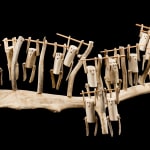-
Artworks
LUKE ANOWTALIK (1932-2006) ARVIAT (ESKIMO POINT)
Composition with Acrobats, mid-late 1980santler and wood, 12 x 40.5 x 19.5 in (30.5 x 102.9 x 49.5 cm)
unsigned.LOT 16
ESTIMATE: $7,000 — $10,000
PRICE REALIZED: $12,000.00
A world record for the artist at auctionFurther images
Born at the inland Ahiarmiut (Caribou Inuit) camp at Ennadai Lake, Luke Anowtalik became one of Arviat's most important artists. Well known for his stone depictions of family groups and...Born at the inland Ahiarmiut (Caribou Inuit) camp at Ennadai Lake, Luke Anowtalik became one of Arviat's most important artists. Well known for his stone depictions of family groups and people and animals, he also began carving relatively complex caribou antler compositions as early as 1970. The Ahiarmiut relied almost entirely on the caribou for every aspect of their material existence. For Anowtalik then, the connection between humans and caribou was absolute, both physically and spiritually. Anowtalik’s antler works are more festive than narrative, usually depicting imaginary groupings of humans, birds, caribou, and other animals. Anowtalik’s antler art is perhaps the epitome of the Arviat tradition of playful “folk art.” George Swinton reminds us: “One of the Inuktitut words used in earlier times for carvings was pinguaq, meaning toy (or ‘playful imitation’), as opposed to sananguaq which has now acquired the meaning of ‘carving’ and of ‘art’ in general. The ethic of making a carving a pinguaq is still pretty strong in Eskimo Point” [1].
Among the most delightful of Anowtalik’s antler creations are his depictions of acrobats. Composition with Acrobats is one of the largest and most impressive examples we have seen. This whimsical, joyful masterpiece is animated not only by the marvelous little human figures; the various antler pillars which support the crossbars and acrobats twist and branch out as if part of the action; even the base exudes a sense of animal sensuality. Anowtalik’s great genius was his ability to convey the life force inherent in his favourite carving material. With Composition of Acrobats, he has also given us the rare opportunity to “play” with a sculpture. Indeed, how could one resist giving it just a little poke or a jiggle?
1. See Swinton’s essay “Memories of Eskimo Point 1967-1979” in Driscoll, Eskimo Point/Arviat, (WAG, 1982), p. 14.
References: Perhaps the earliest known example of an acrobat by Anowtalik, from c. 1971-72, is illustrated in Darlene Coward Wight, The Faye and Bert Settler Collection, (Winnipeg: Winnipeg Art Gallery, 2004), p. 45.
For a somewhat smaller but similarly complex and important example see Walker’s Auctions, Ottawa, 4 November 2012, Lot 102, For a smaller but quite similar work from 1975, in the collection of the National Gallery of Canada, see George Swinton, Sculpture of the Inuit, (Toronto: McClelland & Stewart, 1992), fig. 863; see also Two Acrobats also from 1975 in the Swinton Collection at the WAG in Bernadette Driscoll, Eskimo Point/Arviat, (WAG, 1982), cat. 5.Provenance
Collection of John and Joyce Price, Seattle.
Join our mailing list
* denotes required fields
We will process the personal data you have supplied in accordance with our privacy policy (available on request). You can unsubscribe or change your preferences at any time by clicking the link in our emails.












